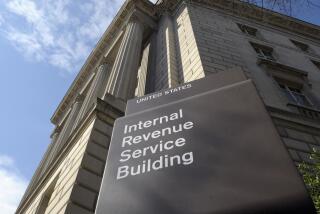It’s Time to Act to Reduce Tax Bite for This Year
- Share via
At this time of year people are already thinking about the upcoming holiday season. But what many people forget is that these days should also launch tax-planning season for most Americans.
Although many consider tax planning far less pleasant than buying presents for their friends and family, some swift moves now can save you a bundle in April. And, done right, tax planning can be simpler than finding a good parking space at the mall.
What can you do now to cut the federal government’s tax bite?
The key to tax planning is usually to accelerate deductions and delay recognizing income. However, because the top tax brackets are still in the 30% range, consumers should generally steer away from doing anything they wouldn’t ordinarily do just to save taxes.
It does not make sense to spend a dollar to save 30 cents.
With that said, there are probably a number of things you are planning to do in the coming months that will affect your tax picture. You may be planning to save money for retirement, give to charity or pay state and local taxes, for example. You’re planning to sell a money-losing stock? Expect a Christmas bonus? How and when you do these things could have a significant effect on your tax bill next April.
Where to begin: It’s a good idea to start by doing an income tax projection, where you essentially fill out the appropriate tax forms by estimating how much you’ll earn in wages, tips and on investments. You then estimate your deductions and take a look at how much you have paid and might owe in federal taxes.
Your projection should do several things: First, it will give you a starting point so you can compare how much you can save by employing a handful of simple tax-saving strategies.
Second, it will let you know whether you are flirting with the alternative minimum tax. The AMT is a parallel tax system that kicks in for those who have large amounts of particular types of deductions. With the AMT, the government allows taxpayers a lower overall rate, but they get credit for fewer deductions. In the end, they pay more tax.
And finally, your projection will let you know if you are at risk of underpayment penalties.
If you have paid less than 100% of your 1990 tax liability or less than 90% of your estimated 1991 liability, you should act now to resolve the problem before you are faced with these fines for underpayment. (Since estimates of 1991 liability are fallible, it’s often best to make sure you paid in at least 100% of last year’s tax to avoid underpayment penalties.)
Although the fines will vary based on the specifics of each situation, these fines are generally huge. It never makes sense to incur them on purpose or because of carelessness.
If you find that an underpayment penalty is likely, you have two choices: Either immediately boost your federal withholding at work or try to work out a tax plan that reduces your overall liability and makes additional payments unnecessary.
What you probably don’t want to do is increase the size of your estimated tax payments. The reason: The Internal Revenue Service expects you to make estimated tax payments in equal installments throughout the year. If your final payment--due Jan. 15--is much higher than those made in the beginning of the year, you may still trigger tax penalties.
However, you can fix underpayments by adjusting your federal withholding at work without risking underpayment penalties. Regardless of the way it comes in, the IRS generally considers withholding to have been deducted in equal installments throughout the year.
The reason is a practical matter, said Philip J. Holthouse, a certified public accountant from West Los Angeles. If you work for a big company, your employer sends in millions of dollars of tax withholding payments each year. The IRS does not have an effective way of checking how much of those millions related to the underpayments of particular workers. (It is not wise to try to cheat the system by underpaying on purpose, however. You never know when the system will improve and you’ll get caught.)
To adjust your withholding, you need only to get a W-4 form from your employer. To make sure that they withhold the right amount, divide the amount that you will owe by the number of pay periods left before year-end. And put that figure beside the line that asks if you would like additional tax withheld. For example, you expect to owe $2,000 more than you paid and four pay periods remain. You put $500 on this line and your employer will automatically deduct an extra $500 each pay period.
However, before you go through the trouble of sending the federal government more money, you might be wise to do your best to reduce your tax through timely gifts to charity, contributions to tax-favored retirement plans, and, possibly, through other means also.
For guidance on these options, look for coming articles in this series that deal with charitable contributions, retirement plans, accelerating deductible payments and delaying receipt of taxable income. You also might consider investing in one of the last remaining “true” tax shelters--low-income housing--which can provide considerable tax breaks while exposing investors to considerable risks as well.
More to Read
Inside the business of entertainment
The Wide Shot brings you news, analysis and insights on everything from streaming wars to production — and what it all means for the future.
You may occasionally receive promotional content from the Los Angeles Times.










